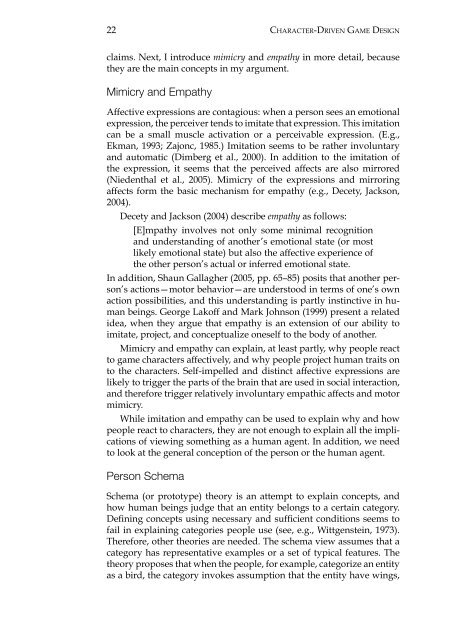Character Driven Game Design
Character Driven Game Design
Character Driven Game Design
Create successful ePaper yourself
Turn your PDF publications into a flip-book with our unique Google optimized e-Paper software.
22<br />
<strong>Character</strong>-<strong>Driven</strong> <strong>Game</strong> <strong>Design</strong><br />
claims. Next, I introduce mimicry and empathy in more detail, because<br />
they are the main concepts in my argument.<br />
Mimicry and Empathy<br />
Affective expressions are contagious: when a person sees an emotional<br />
expression, the perceiver tends to imitate that expression. This imitation<br />
can be a small muscle activation or a perceivable expression. (E.g.,<br />
Ekman, 1993; Zajonc, 1985.) Imitation seems to be rather involuntary<br />
and automatic (Dimberg et al., 2000). In addition to the imitation of<br />
the expression, it seems that the perceived affects are also mirrored<br />
(Niedenthal et al., 2005). Mimicry of the expressions and mirroring<br />
affects form the basic mechanism for empathy (e.g., Decety, Jackson,<br />
2004).<br />
Decety and Jackson (2004) describe empathy as follows:<br />
[E]mpathy involves not only some minimal recognition<br />
and understanding of another’s emotional state (or most<br />
likely emotional state) but also the affective experience of<br />
the other person’s actual or inferred emotional state.<br />
In addition, Shaun Gallagher (2005, pp. 65–85) posits that another person’s<br />
actions—motor behavior—are understood in terms of one’s own<br />
action possibilities, and this understanding is partly instinctive in human<br />
beings. George Lakoff and Mark Johnson (1999) present a related<br />
idea, when they argue that empathy is an extension of our ability to<br />
imitate, project, and conceptualize oneself to the body of another.<br />
Mimicry and empathy can explain, at least partly, why people react<br />
to game characters affectively, and why people project human traits on<br />
to the characters. Self-impelled and distinct affective expressions are<br />
likely to trigger the parts of the brain that are used in social interaction,<br />
and therefore trigger relatively involuntary empathic affects and motor<br />
mimicry.<br />
While imitation and empathy can be used to explain why and how<br />
people react to characters, they are not enough to explain all the implications<br />
of viewing something as a human agent. In addition, we need<br />
to look at the general conception of the person or the human agent.<br />
Person Schema<br />
Schema (or prototype) theory is an attempt to explain concepts, and<br />
how human beings judge that an entity belongs to a certain category.<br />
Defining concepts using necessary and sufficient conditions seems to<br />
fail in explaining categories people use (see, e.g., Wittgenstein, 1973).<br />
Therefore, other theories are needed. The schema view assumes that a<br />
category has representative examples or a set of typical features. The<br />
theory proposes that when the people, for example, categorize an entity<br />
as a bird, the category invokes assumption that the entity have wings,
















